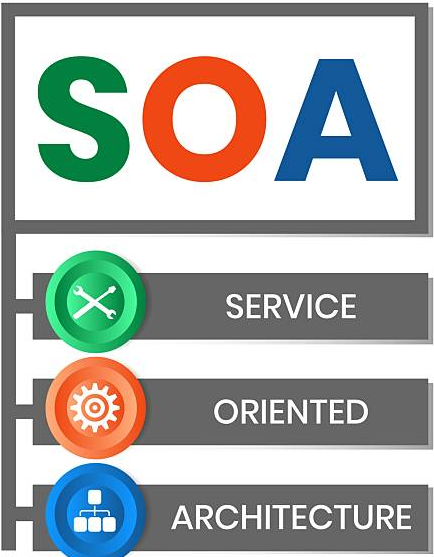Service-Oriented Architecture (SOA) continues to shape the future of software development, enabling businesses to build flexible, scalable, and efficient systems. By breaking down applications into modular, interoperable services, SOA allows organizations to adapt to changing market demands while optimizing resources. As technology evolves, new trends in SOA are transforming how software is designed, deployed, and managed. In this article, we explore the top SOA trends driving innovation in 2025 and beyond.
1. Rise of Microservices as the Evolution of SOA
Microservices have emerged as a modern iteration of SOA, taking modularity to the next level. Unlike traditional SOA, which often involves larger, more complex services, microservices focus on smaller, independent units that perform specific functions. This trend allows developers to deploy, scale, and update services independently, reducing system downtime and improving agility.
Microservices align with SOA principles but leverage containerization technologies like Docker and Kubernetes for seamless deployment. This enables organizations to build highly scalable applications that can handle fluctuating workloads. For example, e-commerce platforms can scale payment processing services during peak shopping seasons without affecting other system components. As businesses prioritize speed and flexibility, microservices are becoming a cornerstone of SOA-driven software development.
2. Integration with Cloud-Native Architectures
Cloud computing has revolutionized software development, and SOA is no exception. The integration of SOA with cloud-native architectures is a significant trend, enabling organizations to leverage the scalability and cost-efficiency of cloud platforms. Cloud providers like AWS, Azure, and Google Cloud offer tools that align with SOA principles, such as serverless computing and managed services.
Serverless architectures, in particular, complement SOA by allowing developers to focus on building services without managing underlying infrastructure. This reduces operational overhead and accelerates time-to-market. For instance, a financial services company can use serverless functions to process transactions in real time, integrating seamlessly with existing SOA frameworks. As cloud adoption grows, SOA’s synergy with cloud-native technologies will continue to drive innovation.
3. Event-Driven Architecture for Real-Time Processing
Event-driven architecture (EDA) is gaining traction as a complement to SOA, enabling real-time data processing and responsiveness. In an event-driven SOA, services communicate through events, such as user actions or system triggers, rather than direct requests. This approach is ideal for applications requiring low latency, such as IoT systems or real-time analytics platforms.
For example, a smart home application can use EDA within an SOA framework to process sensor data and trigger actions like adjusting lighting or temperature. By integrating EDA, businesses can create responsive systems that adapt to user needs instantly. This trend is particularly relevant for industries like healthcare, where real-time patient monitoring can improve outcomes.
4. API-First Design and API Management
APIs are the backbone of SOA, enabling services to communicate seamlessly. The shift toward API-first design is a key trend, emphasizing the creation of well-documented, reusable APIs from the outset of development. This approach ensures that services are interoperable and can be easily integrated with third-party systems.
API management platforms are also becoming critical in SOA environments. Tools like Apigee and MuleSoft allow organizations to monitor, secure, and optimize APIs at scale. For instance, a retail company can use API management to streamline interactions between its inventory, payment, and customer service systems. As APIs grow in complexity, robust management solutions will be essential for maintaining SOA efficiency.
5. Enhanced Security with Zero Trust Architecture
Security remains a top priority in software development, and SOA is adapting by incorporating zero trust principles. Zero trust architecture assumes that no user or service is inherently trustworthy, requiring continuous authentication and authorization. In SOA, this means securing each service interaction, whether internal or external.
For example, a banking application using SOA can implement zero trust to verify every API call, protecting sensitive customer data. Technologies like OAuth 2.0 and JWT (JSON Web Tokens) are commonly used to enforce secure communication between services. As cyber threats evolve, integrating zero trust into SOA will be critical for safeguarding systems.
6. AI and Machine Learning Integration
Artificial intelligence (AI) and machine learning (ML) are transforming SOA by enabling smarter, data-driven services. AI-powered services can analyze large datasets, predict user behavior, and automate decision-making. In an SOA context, these capabilities are implemented as modular services that integrate with existing systems.
For instance, a logistics company can use an AI-driven SOA service to optimize delivery routes based on real-time traffic data. By decoupling AI functionality into standalone services, organizations can update or scale these components without disrupting the entire system. As AI adoption grows, its integration with SOA will drive more intelligent and efficient software solutions.
7. Focus on Interoperability and Standards
Interoperability is a core principle of SOA, and recent trends emphasize standardized protocols to ensure seamless communication between services. Standards like OpenAPI, gRPC, and GraphQL are gaining popularity for defining service interfaces. These standards simplify integration and improve compatibility across diverse systems.
For example, a healthcare provider can use GraphQL in an SOA framework to query patient data from multiple sources efficiently. By adhering to industry standards, organizations can avoid vendor lock-in and ensure their systems remain future-proof. This trend is particularly important as businesses increasingly rely on multi-vendor ecosystems.
Explore Related Innovations
To dive deeper into next-gen SOA models and real-world applications, check out:
👉 SOA OS23 – An advanced architecture framework offering insights into optimizing modern service-oriented systems.
👉 CFLOP-Y44551/300 – A strategic blueprint for large-scale SOA deployments focusing on reliability, flexibility, and cloud optimization.
Conclusion
Service-Oriented Architecture remains a powerful approach to building flexible, scalable software systems. The trends outlined above—microservices, cloud-native integration, event-driven architecture, API-first design, zero trust security, AI integration, and interoperability standards—reflect the evolution of SOA in response to modern technological demands. By embracing these trends, businesses can create robust, future-ready applications that drive innovation and efficiency.
As SOA continues to evolve, staying ahead of these trends will be crucial for organizations looking to maintain a competitive edge. Whether you’re a developer, architect, or business leader, understanding and implementing these SOA advancements will position your software for success in an ever-changing digital landscape.
